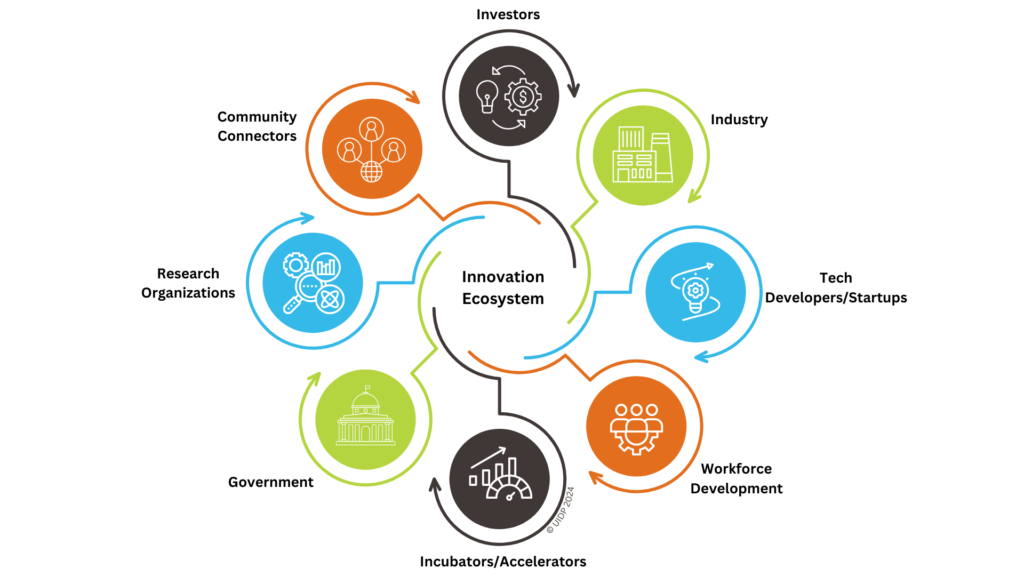Fueling the Future: Assessing and Advancing Innovation Ecosystems
Feb. 6, 2024 —Building and strengthening innovation ecosystems is a hot topic in the world of cross-sector research partnerships. Large-scale funding opportunities in the United States and beyond have generated hundreds of responses from regions eager to boost their economic development efforts. With the January 29 announcement of the inaugural U.S. National Science Foundation (NSF) Regional Innovation Engines, the upcoming results of the EU’s Regional Innovation Valleys in March, and the final awards for the U.S. Economic Development Administration (EDA) Tech Hubs program coming later this year, understanding how ecosystems grow and how to leverage the benefits they provide is top of mind today.
—Building and strengthening innovation ecosystems is a hot topic in the world of cross-sector research partnerships. Large-scale funding opportunities in the United States and beyond have generated hundreds of responses from regions eager to boost their economic development efforts. With the January 29 announcement of the inaugural U.S. National Science Foundation (NSF) Regional Innovation Engines, the upcoming results of the EU’s Regional Innovation Valleys in March, and the final awards for the U.S. Economic Development Administration (EDA) Tech Hubs program coming later this year, understanding how ecosystems grow and how to leverage the benefits they provide is top of mind today.
Framing success
At UIDPVirtual 2023, Kristen Sproat of Boston Consulting Group and Emily Knight of the Engine Accelerator outlined the role of six innovation enablers. According to Sproat, at its core, a place’s economic, social, and environmental capital are inputs for ideas and the ability to commercialize and scale them for economic, social, and environmental impact. Six enablers must be present in the ecosystem: research, funding/investment, talent/culture, infrastructure/data, networks, and community.
Each enabler plays a distinct role in the ecosystems. While research brings novel ideas to underpin innovation, the funding/investment supports innovation at every stage, from initial research to late-stage mature companies. Talent and culture include the people with ideas, others who can create businesses, those who can scale them, and the supply chain partners that make growth possible. Infrastructure can be both physical and virtual; research can flourish in universities, research parks, innovation centers, and virtual spaces. Networks are the connections and partnerships that connect ideas and allow them to grow. Community is a more nuanced aspect of ecosystems; Sproat likened community to the characteristics that make innovation “sticky,” including a sense of support, the livableness of the location, and positive facets of a place that keep innovators and businesses local.
Sproat noted that nearly half of innovation ecosystems fail due to inadequate governance. With many moving parts comprising the ecosystem, a central governing body is necessary to oversee decisions, directions, and funding. The governing body must be dedicated to solving complex issues and balancing the needs and goals of all stakeholders, all while pushing the ecosystem to grow and expand.
A number of organizations have put forward frameworks identifying successful stakeholders in an innovation ecosystem; UIDP shared a graphic at a workshop last week in Washington, DC, illustrating eight that are often referenced in these discussions.
 New ecosystems
New ecosystems
NSF’s inaugural Regional Innovation Engines awards went to 10 teams of universities, businesses, nonprofits, and other partners (additional partners are welcome to become part of each team as the projects get rolling). These teams will receive $15 million over the next two years and potentially up to $160 million over the next decade. Importantly, each of the winning teams demonstrated private-sector support for their projects, a strong indication of regional buy-in. NSF has signaled its interest in learning more about the impact of these investments in innovation ecosystems through metrics, including tangible translation and commercialization outcomes in the technology areas they will pursue.
Last October, the EDA announced the first round of Tech Hubs awards, which included 31 teams of diverse public and private partners. These teams are eligible to apply for the next funding phase, with the EDA looking to fund three to eight teams. The Phase Two notice is open until Feb. 29, 2024, and selected teams will be announced this summer.
Last year, the European Commission opened the first calls under the Regional Innovation Valleys initiative to strengthen EU innovation. Over 50 proposals were submitted, with nearly 1000 participants from 25 member states and six associated countries. The Regional Innovation Valleys initiative aims to unite regions across the EU to strengthen research and innovation in specific domains while addressing local challenges and needs. The results will be announced in March.
As these ecosystems mature, there will be ample opportunities for engagement and partnerships, allowing more organizations to join and drive collaborative innovation. The success of the NSF Engines, EDA Tech Hubs, EU Regional Innovation Valleys, and similar programs could reshape the way collaboration and partnerships evolve, creating a network of interconnected regions specializing in key technology areas and the economic development they catalyze.
Why it matters
Innovation ecosystems involve diverse stakeholders and have the potential for long-term economic impact. Understanding their success elements in a replicable way is yet uncharted territory, but it has the potential to shape the trajectory of technological advancement and economic growth around the world.
We want to hear from you. Is your organization part of a regional innovation ecosystem? Let us know on our LinkedIn profile.


